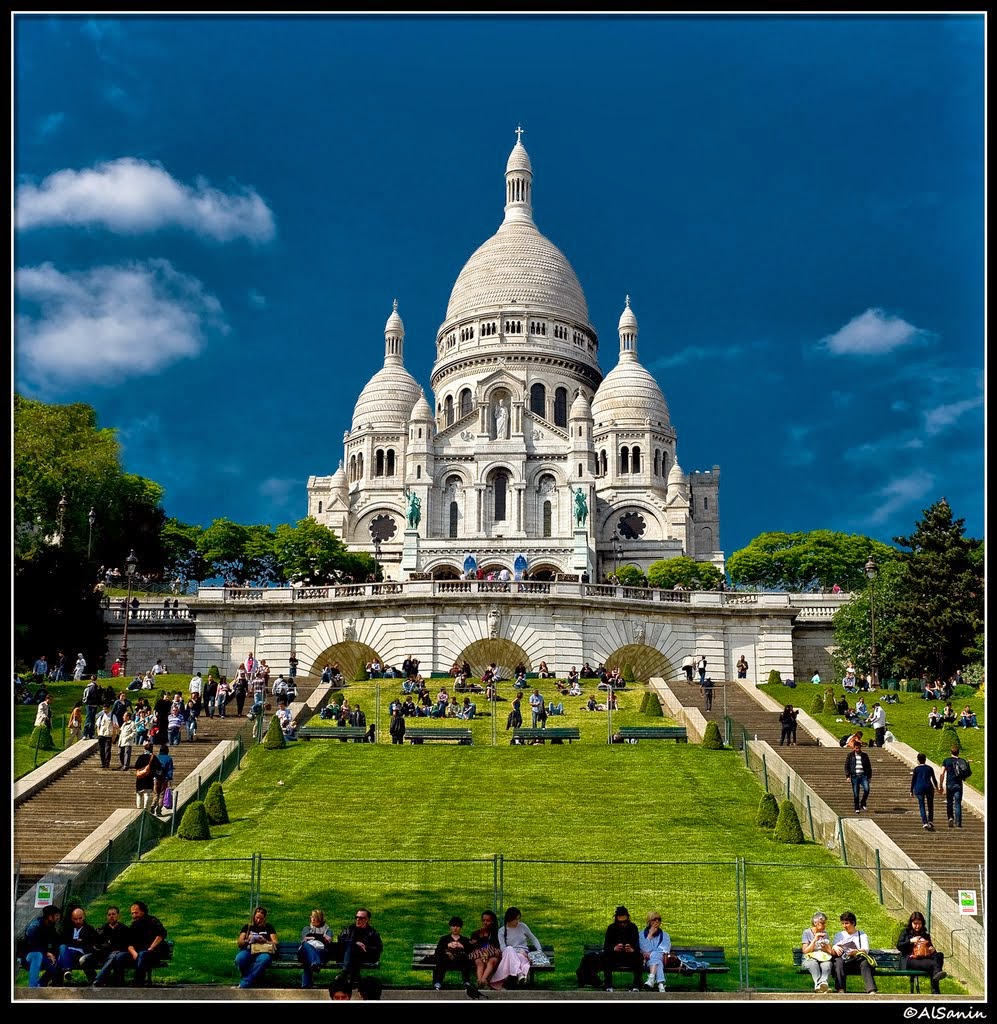Perched atop the highest point in Paris, the Sacré-Cœur Basilica is more than just a stunning architectural marvel; it’s a symbol of faith, resilience, and national identity. Its gleaming white dome, visible from nearly every corner of the city, beckons visitors to ascend Montmartre and experience the unique blend of spiritual serenity and panoramic views that this sacred space offers. A key element of its allure is its impressive altitude, which contributes significantly to its iconic status and historical context.
The Ascent to Montmartre: Understanding the Basilica’s Height
The Sacré-Cœur Basilica sits at an altitude of 130 meters (427 feet) above sea level. This height is a combination of the natural elevation of Montmartre hill and the architectural height of the basilica itself. Montmartre, which translates to "Mount of the Martyr," has been a site of religious significance since ancient times. It’s believed to be where Saint Denis, the patron saint of Paris, was martyred in the 3rd century.
The decision to build the basilica on this particular location was no accident. In the aftermath of the Franco-Prussian War (1870-1871) and the tumultuous Paris Commune, the French National Assembly sought a way to atone for what they perceived as the moral failings that had led to the nation’s defeat. The idea of constructing a church dedicated to the Sacred Heart of Jesus, high above the city, was seen as a way to purify the land and restore national pride.
Architectural Grandeur Reaching for the Heavens
The basilica’s design, conceived by architect Paul Abadie, is a striking example of Romano-Byzantine architecture. Its most prominent feature is its large central dome, which rises to a height of 83 meters (272 feet). When combined with the elevation of Montmartre, the top of the dome reaches an approximate total altitude of 213 meters (699 feet) above sea level. This makes it one of the highest points in Paris.
The basilica’s elevated position was a deliberate choice to make it a visible landmark throughout the city. The gleaming white travertine stone, quarried from Château-Landon, was specifically chosen for its self-cleaning properties, ensuring that the basilica would maintain its brilliant appearance for generations to come.
A Panaromic Vista: The Spiritual and Physical High Point of Paris
One of the most rewarding aspects of visiting the Sacré-Cœur Basilica is the breathtaking panoramic view it offers. From the parvis (the terrace in front of the basilica), visitors can see a vast expanse of Paris stretching out before them. On a clear day, the view extends to the distant suburbs and beyond. The Eiffel Tower, Notre Dame Cathedral, and other iconic landmarks are clearly visible, providing a unique perspective on the city’s layout and architectural diversity.
The altitude enhances this experience, giving visitors a sense of being above the hustle and bustle of the city. It’s a place where one can pause, reflect, and appreciate the beauty of Paris from a unique vantage point. The panoramic vista from the basilica is not merely a visual treat; it’s an integral part of the overall experience, connecting visitors to the city’s history, culture, and spiritual heritage.
Spiritual Significance and the Basilica’s Purpose
The Sacré-Cœur Basilica is more than just a tourist attraction; it’s a place of worship and spiritual reflection. The interior of the basilica is richly decorated with mosaics, stained glass windows, and sculptures, all designed to inspire awe and reverence. The most prominent feature is the large mosaic above the altar, which depicts Christ with his Sacred Heart exposed.
The basilica is dedicated to the Sacred Heart of Jesus, a symbol of divine love and compassion. It serves as a place of perpetual adoration, with continuous prayer and worship taking place throughout the day and night. Visitors are welcome to attend Mass, participate in prayer services, or simply spend time in quiet contemplation.
The basilica’s elevated position reinforces its spiritual significance. It’s a place where one can feel closer to God, removed from the distractions of the world below. The climb to the top of Montmartre can be seen as a metaphor for the spiritual journey, a process of ascending to a higher plane of consciousness.
Historical Context and the Basilica’s Legacy
The construction of the Sacré-Cœur Basilica was a controversial project from the start. Some saw it as a symbol of religious conservatism and a reminder of France’s defeat in the Franco-Prussian War. Others viewed it as a necessary act of atonement and a symbol of national renewal.
Despite the controversy, the basilica was completed in 1914 and quickly became a beloved landmark. Over the years, it has served as a place of pilgrimage, a symbol of hope, and a testament to the enduring power of faith.
Today, the Sacré-Cœur Basilica is one of the most visited sites in Paris. Millions of people from all over the world come each year to admire its architecture, enjoy its panoramic views, and experience its spiritual atmosphere. Its elevated position continues to play a crucial role in its appeal, drawing visitors to the highest point in Paris for a unique and unforgettable experience.
Experiencing the Altitude: Practical Tips for Visitors
Visiting the Sacré-Cœur Basilica requires a bit of planning, especially considering its altitude. Here are some practical tips to make your visit more enjoyable:
- Wear Comfortable Shoes: The climb to the top of Montmartre can be strenuous, especially if you choose to walk up the stairs. Comfortable shoes are essential.
- Consider Transportation Options: If you’re not up for the walk, you can take the funicular, a cable car that ascends the hill. Alternatively, you can take a taxi or bus to the base of the basilica and then walk the remaining distance.
- Be Prepared for Crowds: The Sacré-Cœur Basilica is a popular tourist destination, so expect crowds, especially during peak season. Arriving early in the morning or later in the afternoon can help you avoid the worst of the crowds.
- Dress Respectfully: As a place of worship, it’s important to dress respectfully when visiting the basilica. Avoid wearing revealing clothing or hats.
- Take Your Time: Allow plenty of time to explore the basilica and enjoy the panoramic views. Don’t rush your visit.
- Check the Weather: The weather on Montmartre can be unpredictable, so check the forecast before you go. Bring a jacket or umbrella if necessary.
- Stay Hydrated: The climb to the top of Montmartre can be dehydrating, so be sure to drink plenty of water.
In Conclusion: A Sacred Summit
The Sacré-Cœur Basilica, with its impressive altitude and stunning architecture, is a testament to the enduring power of faith, art, and human aspiration. Its elevated position on Montmartre not only offers breathtaking panoramic views of Paris but also enhances its spiritual significance, making it a truly unique and unforgettable destination. Whether you’re a religious pilgrim, an art enthusiast, or simply a curious traveler, a visit to the Sacré-Cœur Basilica is an experience that will leave you feeling inspired and uplifted. It’s a beacon of faith high above the city, inviting all who seek beauty, solace, and a connection to something greater than themselves.

